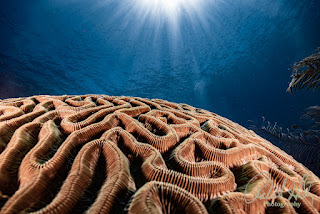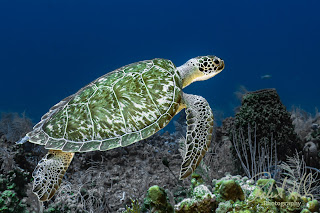Batch Masking in Lightroom: Automating Edits Across Dive Series with AI (2025 Update)
🪸 Robert Herb Photography Blog
Have you ever finished a dive and come up with a memory card full of amazing underwater shots, only to feel overwhelmed by the prospect of editing dozens of similar photos? Especially when many of those images are taken under the same lighting conditions, at similar depths, or of the same reef, shipwreck, or marine life? If this situation sounds familiar, you're in the right place. As underwater photographers, it's common to capture a series of images that look pretty alike. This can make the editing process feel tedious and repetitive.
Fortunately, Adobe Lightroom Classic has introduced an exciting new feature that can significantly speed up and enhance the efficiency of your editing workflow: AI-Powered Batch Mask Duplication. This is a significant update that goes beyond just syncing global settings across your photos; it actually allows you to quickly duplicate complex, selective masks across a series of images, saving you time and effort.
In previous versions of Lightroom, applying masks, such as "Select Subject" or "Select Water," to each photo had to be done manually, one by one, which could be time-consuming, especially when working with large batches. Now, with this new AI-powered feature, you can create a mask on one image and then easily duplicate and adapt it to other photos in the series, even if they have different compositions, focal lengths, or abstract lighting conditions. Lightroom's AI intelligently adjusts each mask to suit the specific image, meaning your edits stay precise and natural-looking.
Whether you're a professional underwater photographer or an enthusiast looking to streamline your workflow, this update helps you accomplish complex editing tasks more quickly, so you can spend more time capturing stunning images and less time in front of the computer. It's a perfect example of how technology continues to evolve to serve creative artists like you, making your work more efficient while maintaining the high quality and artistic control you strive for.
Let's explore how this feature dramatically reduces editing time and why it's a game-changer for our Oceanic Explorer audience, who would rather be diving than fussing with brush tools.
Why Batch Masking is a Big Deal for Underwater Photography
Underwater photography captures some of the most dynamic and chaotic scenes, with swirling particles, light falloff, and quickly moving subjects. When editing a batch of photos taken during a single dive, it's often helpful to apply consistent adjustments such as exposure recovery, Clarity, and shadow enhancement across the entire series to ensure a cohesive look.
In earlier versions of Lightroom before 14.4, syncing masks across multiple photos had limitations. The process simply copied the shape and position of the mask exactly as it was in the original image, which often led to misalignments or less-than-ideal results because each underwater shot can have slight variations.
However, with the introduction of AI-powered Batch Mask Duplication, Lightroom has significantly improved this workflow. This intelligent feature analyzes each image in your series and then dynamically recreates the mask contextually based on the content of each photo. As a result, it saves you time and effort by automating what used to be a tedious manual process of reselecting your subject in every shot.
This advancement allows you to spend more of your precious editing time exploring your creative ideas and fine-tuning your images rather than repeatedly adjusting masks. It's a great example of how AI integration continues to make post-processing more efficient, effective, and accessible, particularly in challenging shooting conditions such as underwater photography.
How to Use Batch AI Masking in Lightroom Classic (v14.4)
Here's a simple walkthrough to automate edits across a series:
✅ Step-by-Step Guide
-
Edit your "base" image first.
-
Choose one representative photo from your dive series.
-
Apply global adjustments, then create your AI Masks (like "Select Subject" or "Select Water").
-
-
Create and fine-tune your AI Masks
-
Shortcut to open Masking Panel:
Shift + W -
Use "Select Subject" for a diver, turtle, or fish.
-
Use "Select Water" to isolate the ocean background.
-
Optional: Add Dehaze, Exposure, and Clarity adjustments per mask.
-
-
Select the batch of similar images.
-
Hold
Ctrl(Windows) orCmd(Mac) and click to highlight your target images in the Filmstrip.
-
-
From the main menu, choose:
-
Settings > Develop Settings > Copy Settings
-
In the dialog, ensure "Masks" is checked.
-
-
Paste or Sync Across
-
Use
Ctrl + Shift + V(Windows) orCmd + Shift + V(Mac) to paste onto all selected files. -
Lightroom will regenerate the masks individually for each photo.
-
💡 Pro Tip: The mask will intelligently reposition to match each image's unique subject or background, eliminating the need for manual realignment.
Examples: Using Batch Masking with "Select Water" AI
Let's examine a few real-world underwater editing scenarios where Batch Mask Duplication truly shines.
🐢 Example 1: Bluewater Background Enhancement (Turtle Swim Sequence)
Use case: You have 12 shots of a hawksbill turtle gliding over a sandy bottom in Roatan.
-
In one photo, use "Select Water" to isolate the background.
-
Boost Dehaze (+15), drop Highlights (-20), and bump Vibrance (+10).
-
Batch-copy the mask and settings to the rest.
Result: Cleaner, richer blue tones across the whole set, without retouching each one.
🐠 Example 2: School of Fish with Distracting Backscatter
Use case: Silversides in front of the reef wall, lit by strobes.
-
Mask the "Select Water" to soften the background with reduced Clarity (-15) and Texture (-10).
-
Add a second "Select Subject" mask to enhance the school with added Clarity (+20).
-
Sync all adjustments to 15 similar frames with one click.
🎯 Keyboard Shortcuts:
-
Masking Tool:
Shift + W -
Copy Settings:
Ctrl + Shift + C -
Paste Settings:
Ctrl + Shift + V
🌊 Example 3: Murky Water with Subject Silhouette
Use case: A diver silhouette descending into greenish-blue water at 65 feet.
-
Mask the water: Increase exposure (+0.20) and add Color Temp Shift (+5) to neutralize the murk.
-
Mask the diver separately and increase Contrast for a more substantial silhouette impact.
-
Paste across 10 images from the same descent sequence, and the AI will re-target both masks per image.
🐡 Example 4: Coral Closeups with Mixed Light
Use case: Macro shots of a lionfish under a coral overhang with backlit shadows.
-
Create a "Select Subject" mask for the lionfish and increase Shadows (+40).
-
Use a Luminance Range Mask on the background to balance light falloff.
-
Apply settings across all frames from the same lighting condition.
🚤 Example 5: Surface Shots with Bubbles and Glare
Use case: Shooting up toward the surface with divers ascending.
-
Use "Select Water" and reduce Highlights (-25) and Dehaze (+10).
-
Add a brush refinement if necessary using
Kkey. -
Duplicate this setup across all surface shots to save you 20+ minutes easily!
Bonus: Lightroom Mobile Batch Edits (v9.4)
Yes, even on the go, Lightroom Mobile now supports AI Masking and syncing!
-
Tap the Masking icon on your edited image.
-
Use the three-dot menu, select "Copy Settings," and then paste it into other photos in the album.
-
Lightroom intelligently reapplies masks with mobile-friendly accuracy.
Ideal for when you're editing from your tablet during a surface interval or airport layover.
Why This Matters for Oceanic Explorers
As underwater photographers, our primary goal is to tell compelling stories from beneath the water's surface. We want to focus on capturing beautiful, impactful images without wasting time on repetitive edits. That's where the Batch Masking feature really comes in handy. It's designed to save us time and boost our efficiency, giving us more freedom to concentrate on our narrative and creative aspects.
Previously, editing a series of similar images meant manually adjusting each one repeatedly, which could be time-consuming and frustrating. Now, with batch masking, you can apply the same adjustments to multiple photos simultaneously, making your workflow more efficient and streamlined. This also helps ensure that your edits are consistent across your entire set of images, which is especially important for professional work or displaying your collection cohesively.
Whether you're a hobbyist just starting out or a seasoned pro, mastering tools like batch masking can elevate your photography game. It enables you to produce high-quality, cohesive galleries more quickly, allowing you to spend more time on what truly matters: telling your stories and sharing your creative vision with others.
Keyboard Shortcut Recap
| Action | Shortcut (Win/Mac) |
|---|---|
| Develop Module | D |
| Open Masking Panel | Shift + W |
| Brush Tool | K |
| Copy Settings | Ctrl + Shift + C / Cmd + Shift + C |
| Paste Settings | Ctrl + Shift + V / Cmd + Shift + V |
Final Thoughts: Work Smarter, Not Harder
AI masking isn't about taking away your artistic touch; it's actually about streamlining your editing process by removing unnecessary or repetitive tasks. Once you've fine-tuned your subject and background adjustments to your liking, whether it's color correction, exposure tweaks, or other enhancements, you can easily apply those same edits across your entire underwater dive series with just a few clicks. This means you save time and maintain consistency in your series without sacrificing your creative flair.
Let Lightroom's AI-powered masking do the heavy lifting behind the scenes so you can spend more time focusing on what truly matters: making your underwater images stand out and tell a compelling story. It's like having an intelligent assistant that helps you work smarter, not harder, giving you more freedom to experiment and capture stunning, unforgettable shots.
🧜♂️ Want More?
Join the conversation by sharing your edits with #RobertHerbPhotography.
Subscribe for weekly tips at Robert Herb Photography Blog
Questions? Need help refining your Lightroom workflow?
Please send me a message at bob@robertherb.com; I'd be happy to help!
🧭 What's Next?
🟦 Have you tried the new Batch Masking yet? Share your edits using #RobertHerbPhotography.
🟦 Want to see these workflows in action? Sign up for my upcoming training course at RobertHerb.com or reach out at bob@robertherb.com
🟦 And don't forget—new blogs drop weekly at Robert Herb Photography Blog
Until next time… dive deep, shoot smart, and let Lightroom bring your vision to the surface.
– Bob Herb
Robert Herb Photography
Empowering Underwater Photographers Since 1978
Written by Robert Herb – Empowering underwater photographers to capture and enhance the beauty of our oceans.
Stay tuned for more in-depth insights into underwater photography. Let's dive deeper into the art and craft of capturing the marine world! If you have any comments or suggestions, I'd love to hear them.
Get ready for an exciting underwater photography adventure! For more details on my upcoming online training course, check out my "Training" page at RobertHerb.com or email me at bob@robertherb.com.
Sincerely,
Bob Herb
|
|





Comments
Post a Comment
Please let me know your comments.